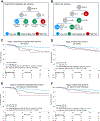Improved Risk-Stratification Scheme for Mismatch-Repair Proficient Stage II Colorectal Cancers Using the Digital Pathology Biomarker QuantCRC
- PMID: 38421684
- PMCID: PMC11062828
- DOI: 10.1158/1078-0432.CCR-23-3211
Improved Risk-Stratification Scheme for Mismatch-Repair Proficient Stage II Colorectal Cancers Using the Digital Pathology Biomarker QuantCRC
Abstract
Purpose: There is a need to improve current risk stratification of stage II colorectal cancer to better inform risk of recurrence and guide adjuvant chemotherapy. We sought to examine whether integration of QuantCRC, a digital pathology biomarker utilizing hematoxylin and eosin-stained slides, provides improved risk stratification over current American Society of Clinical Oncology (ASCO) guidelines.
Experimental design: ASCO and QuantCRC-integrated schemes were applied to a cohort of 398 mismatch-repair proficient (MMRP) stage II colorectal cancers from three large academic medical centers. The ASCO stage II scheme was taken from recent guidelines. The QuantCRC-integrated scheme utilized pT3 versus pT4 and a QuantCRC-derived risk classification. Evaluation of recurrence-free survival (RFS) according to these risk schemes was compared using the log-rank test and HR.
Results: Integration of QuantCRC provides improved risk stratification compared with the ASCO scheme for stage II MMRP colorectal cancers. The QuantCRC-integrated scheme placed more stage II tumors in the low-risk group compared with the ASCO scheme (62.5% vs. 42.2%) without compromising excellent 3-year RFS. The QuantCRC-integrated scheme provided larger HR for both intermediate-risk (2.27; 95% CI, 1.32-3.91; P = 0.003) and high-risk (3.27; 95% CI, 1.42-7.55; P = 0.006) groups compared with ASCO intermediate-risk (1.58; 95% CI, 0.87-2.87; P = 0.1) and high-risk (2.24; 95% CI, 1.09-4.62; P = 0.03) groups. The QuantCRC-integrated risk groups remained prognostic in the subgroup of patients that did not receive any adjuvant chemotherapy.
Conclusions: Incorporation of QuantCRC into risk stratification provides a powerful predictor of RFS that has potential to guide subsequent treatment and surveillance for stage II MMRP colorectal cancers.
©2024 American Association for Cancer Research.
Conflict of interest statement
CW has received research funding (as a clinical trial investigator) from Vaccinex, Boston Biomedical, Lycera, Seattle Genetics, Symphogen, RAPT Therapeutics, and INHBRX. She has also received honoraria from Array Biopharma, Signatera, PrecisCA, and the Oncology Learning Network and served as a consultant to Nova Research Company
RKP1, RK report consulting income from Alimentiv Inc.
RKP2 reports consulting income from Alimentiv Inc., Allergan, and Verily
MBS has received consulting income from Novartis
TBS has received consulting income from Boehringer Ingelheim, TreosBio, Sobi, Ipsen, Array Biopharma, Seattle Genetics, Bayer, Genentech, Incyte, Merck, Boston Biomedical, Bayer, Amgen, Merck, Celgene, Lilly, Ipsen, Clovis, Seattle Genetics, Array Biopharma, Genentech, Abgenomics, Incyte
FS is a consultant for Guardant Health and has received research funding from Ventana Medical Systems
TW-B is an employee of Aiforia Inc.
All other authors report no financial relationships
Figures



References
-
- Lieu C, Kennedy EB, Bergsland E, Berlin J, George TJ, Gill S, et al. Duration of Oxaliplatin-Containing Adjuvant Therapy for Stage III Colon Cancer: ASCO Clinical Practice Guideline. J Clin Oncol 2019;37:1436–47. - PubMed
-
- Baxter NN, Kennedy EB, Bergsland E, Berlin J, George TJ, Gill S, et al. Adjuvant Therapy for Stage II Colon Cancer: ASCO Guideline Update. J Clin Oncol 2022;40:892–910. - PubMed
-
- Böckelman C, Engelmann BE, Kaprio T, Hansen TF, Glimelius B. Risk of recurrence in patients with colon cancer stage II and III: a systematic review and meta-analysis of recent literature. Acta Oncol 2015;54:5–16. - PubMed
-
- André T, Meyerhardt J, Iveson T, Sobrero A, Yoshino T, Souglakos I, et al. Effect of duration of adjuvant chemotherapy for patients with stage III colon cancer (IDEA collaboration): final results from a prospective, pooled analysis of six randomised, phase 3 trials. Lancet Oncol 2020;21:1620–9. - PMC - PubMed
-
- Argilés G, Tabernero J, Labianca R, Hochhauser D, Salazar R, Iveson T, et al. Localised colon cancer: ESMO Clinical Practice Guidelines for diagnosis, treatment and follow-up. Ann Oncol 2020;31:1291–305. - PubMed
Publication types
MeSH terms
Substances
Grants and funding
LinkOut - more resources
Full Text Sources
Medical

